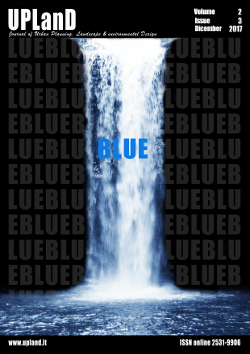Water Sensitive Urban Open Spaces: Comparing North American Best Management Practices
Main Article Content
Abstract
The paper reports about the opportunity to apply the principles of sustainable stormwater management in urban open spaces, as realized in some countries all over the world. Focusing on the design criteria of green streets and emphasizing their multiple benefits, the main technical solutions of best management practices are presented in a glossary proposal. Having selected nine North American mayor cities, to study possible connections between facilities typologies and geographical positions, their climatic features are associated with the technical solutions suggested in the related stormwaters sustainable design manuals and toolkits. The discussion of presented comparisons indicates directions of development for critical reflections and research on the subject, useful for cities still lacking in these technical indications.
Downloads
Download data is not yet available.
Article Details
How to Cite
ValenteR. (2017). Water Sensitive Urban Open Spaces: Comparing North American Best Management Practices. UPLanD - Journal of Urban Planning, Landscape & Environmental Design, 2(3), 285-297. https://doi.org/10.6093/2531-9906/5421
Issue
Section
Articles

This work is licensed under a Creative Commons Attribution-NonCommercial-NoDerivatives 4.0 International License.
Authors who publish with this journal agree to the following terms:- Authors retain copyright and grant the journal right of first publication with the work simultaneously licensed under a Creative Commons Attribution License that allows others to share the work with an acknowledgement of the work's authorship and initial publication in this journal.
- Authors are able to enter into separate, additional contractual arrangements for the non-exclusive distribution of the journal's published version of the work (e.g., post it to an institutional repository or publish it in a book), with an acknowledgement of its initial publication in this journal.
- Authors are permitted and encouraged to post their work online (e.g., in institutional repositories or on their website) prior to and during the submission process, as it can lead to productive exchanges, as well as earlier and greater citation of published work (See The Effect of Open Access).
References
City of Los Angeles (February 2015), Green Sustainable Streets Stormwater Management Guidelines for Public Street Construction and Reconstruction, Energy & Environment Committee Energy & Environment Committee Public Works and Gang Reduction, Retrieved from http://clkrep.lacity.org/onlinedocs/2014/14-0748_misc_2-18-15.pdf
City of Philadelphia (2014), City of Philadelphia Green Streets Design Manual, Retrieved from http://www.phillywatersheds.org/what_were_doing/gsdm
City of Portland (2016), Stormwater Management Manual, Retrieved from https://www.portlandoregon.gov/bes/64040
City of San Francisco (2016), San Francisco Stormwater Management Requirements and Design Guidelines, Retrieved from http://sfwater.org/index.aspx?page=1000
Comune di Firenze (2011), Migliori Pratiche Per La Gestione Sostenibile Delle Acque In Aree Urbane Linee Guida per un regolamento del verde http://www.cirf.org/wp-content/uploads/2017/05/bats_meteoriche.pdf
Comune di Reggio Emilia (April 2014). Linee guida per la gestione delle acque meteoriche, Retrieved from http://www.municipio.re.it/retecivica/urp/retecivi.nsf/PESIdDoc/CD5BC2C6780B17A5C1257CDA0040BAA0/$file/Linee%20guida%20per%20la%20gestione%20delle%20acque%20meteoriche.pdf
Cooperative Research Centre for Water Sensitive Cities (CRCWSC) (2012) Retrieved from https://watersensitivecities.org.au/about-the-crcwsc/
Gibelli G. (2015). Gestione sostenibile delle acque urbane. Manuale di drenaggio urbano. Perché, cosa, come. Regione Lombardia, Ersaf, Milano
James, J.W. (1966). A modified Koeppen classification of California’s climates according to recent data. California Geographer 7, 1-12 + map.
Kompatscher, P. (2008 October), Linee guida per la gestione sostenibile delle acque meteoriche, Provincia Autonoma di Bolzano, Retrieved from www.provincia.bz.it/tutelaacque
Köppen, W. (1936). Das Geographische System der Klimate. In: Köppen W, Geiger R (Eds.), Handbuch der Klimatologie, Vol. 1, Part C. Gebrüder Borntraeger, Berlin, 1-44.
Kurtz, T., (2009). Managing street runoff with green streets. International Low Impact Development Conference Low Impact Development for Urban Ecosystem and Habitat Protection 2008 Edited by Nian She, Michael Char, Seattle, Washington, United States, November 16-19, 2008, American Society of Civil Engineers Book Series
Page, J. (2016, August). Do Green Streets Actually Work for Stormwater Management? Retrieved from http://www.deeproot.com/blog/blog-entries/do-green-streets-work-for-stormwater-management
Page, J. L., et al., (2015). Hydrologic mitigation of impervious cover in the municipal right-of way through innovative stormwater control measures. J. Hydrol. 527: 923-932.
Valente R., Mozingo L.A., (2015). Learning from California: environmental design tools to recover degraded built landscapes” in TECHNE Journal of Technology for Architecture and Environment, 10, 258-267, doi: 10.13128/Techne-17523
City of Philadelphia (2014), City of Philadelphia Green Streets Design Manual, Retrieved from http://www.phillywatersheds.org/what_were_doing/gsdm
City of Portland (2016), Stormwater Management Manual, Retrieved from https://www.portlandoregon.gov/bes/64040
City of San Francisco (2016), San Francisco Stormwater Management Requirements and Design Guidelines, Retrieved from http://sfwater.org/index.aspx?page=1000
Comune di Firenze (2011), Migliori Pratiche Per La Gestione Sostenibile Delle Acque In Aree Urbane Linee Guida per un regolamento del verde http://www.cirf.org/wp-content/uploads/2017/05/bats_meteoriche.pdf
Comune di Reggio Emilia (April 2014). Linee guida per la gestione delle acque meteoriche, Retrieved from http://www.municipio.re.it/retecivica/urp/retecivi.nsf/PESIdDoc/CD5BC2C6780B17A5C1257CDA0040BAA0/$file/Linee%20guida%20per%20la%20gestione%20delle%20acque%20meteoriche.pdf
Cooperative Research Centre for Water Sensitive Cities (CRCWSC) (2012) Retrieved from https://watersensitivecities.org.au/about-the-crcwsc/
Gibelli G. (2015). Gestione sostenibile delle acque urbane. Manuale di drenaggio urbano. Perché, cosa, come. Regione Lombardia, Ersaf, Milano
James, J.W. (1966). A modified Koeppen classification of California’s climates according to recent data. California Geographer 7, 1-12 + map.
Kompatscher, P. (2008 October), Linee guida per la gestione sostenibile delle acque meteoriche, Provincia Autonoma di Bolzano, Retrieved from www.provincia.bz.it/tutelaacque
Köppen, W. (1936). Das Geographische System der Klimate. In: Köppen W, Geiger R (Eds.), Handbuch der Klimatologie, Vol. 1, Part C. Gebrüder Borntraeger, Berlin, 1-44.
Kurtz, T., (2009). Managing street runoff with green streets. International Low Impact Development Conference Low Impact Development for Urban Ecosystem and Habitat Protection 2008 Edited by Nian She, Michael Char, Seattle, Washington, United States, November 16-19, 2008, American Society of Civil Engineers Book Series
Page, J. (2016, August). Do Green Streets Actually Work for Stormwater Management? Retrieved from http://www.deeproot.com/blog/blog-entries/do-green-streets-work-for-stormwater-management
Page, J. L., et al., (2015). Hydrologic mitigation of impervious cover in the municipal right-of way through innovative stormwater control measures. J. Hydrol. 527: 923-932.
Valente R., Mozingo L.A., (2015). Learning from California: environmental design tools to recover degraded built landscapes” in TECHNE Journal of Technology for Architecture and Environment, 10, 258-267, doi: 10.13128/Techne-17523

